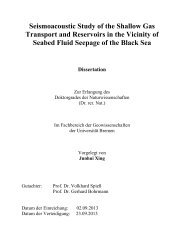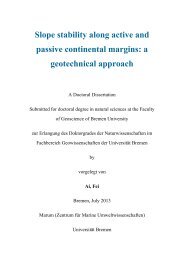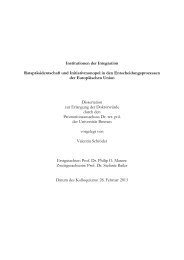aus dem MARUM und dem Fachbereich Geowissenschaften der ...
aus dem MARUM und dem Fachbereich Geowissenschaften der ...
aus dem MARUM und dem Fachbereich Geowissenschaften der ...
Create successful ePaper yourself
Turn your PDF publications into a flip-book with our unique Google optimized e-Paper software.
MARIA S. MERIAN-Berichte, Cruise 20, Leg 4, Bridgetown – Freeport, 15.3.2012 – 7.4.2012<br />
16313). The live fauna fo<strong>und</strong> in these box cores comprises crinoids, polychaetes, sponges,<br />
bryozoans, barnacles (attached to corals), brachiopods, echinoids, hydroids, foraminifera, and<br />
decapods. The fossil remnants comprise scaphopods, pteropods, gastropods, and bivalves. Two<br />
off-mo<strong>und</strong> box cores (GeoB 16319, 16320) revealed a similar overall sediment composition<br />
(pteropod foraminiferal ooze), however, with a much reduced living and fossil fauna.<br />
A peculiar feature detected on the detailed bathymetric map was a set of two "crater-like"<br />
structures slightly deeper than the belt of CWC mo<strong>und</strong>s (Fig. 6.4). Due to the almost perfect<br />
circular structure of the central depressions of these structures encircled by a rim it has been<br />
speculated that they might represent a kind of seep structure. However, detailed PARASOUND<br />
imaging revealed that layered sediments continue beneath these structures and that they do not<br />
have any roots. POSIDONIA-controlled box core sampling of one of the central depressions<br />
(GeoB 16321) revealed a common regional hemipelagic sediment matrix with ab<strong>und</strong>ant CWC<br />
fragments. The observation that these fragments are the most abraded encountered in this region,<br />
might imply that these structures represent fossil CWC mo<strong>und</strong>s, possibly related to a lower sea<br />
level in the past. Detailed descriptions of all box cores collected are given in Appendix 2.<br />
For reconstructing the long-term development of CWC in the Campeche Bank area, three<br />
gravity cores were taken from the ridges with all of them containing ab<strong>und</strong>ant CWC fragments.<br />
The first site (GeoB 16310) was sampled twice as the first attempt with a 6-m-long core barrel<br />
suffered from significant over-penetration. During a second attempt using a 12-m-long core<br />
barrel a 10.6-m-long record was recovered. Two other cores resulted in 2.5-m (GeoB 16313) and<br />
4.7-m-long (GeoB 16318) records of coral-bearing sediments. It needs to be noted that core<br />
GeoB 16313 penetrated much deeper into the sediment. However, regarding the rope tension<br />
record it appeared that a large part of the core has been lost when the corer was pulled out of the<br />
sea floor, probably bec<strong>aus</strong>e the sediment column disrupted beneath a semi-lithified horizon,<br />
which forms the lowest part of the retrieved record. Overall, the mo<strong>und</strong>s along the Campeche<br />
Bank appear to represent typical coral mo<strong>und</strong>s formed by CWC fragments embedded in a matrix<br />
of hemipelagic sediments.<br />
In addition, three so-called off-mo<strong>und</strong> cores were taken to retrieve <strong>und</strong>isturbed palaeoceanographic<br />
records to reconstruct regional palaeo-environmental changes in the past that might have<br />
controlled CWC development. The first site (GeoB 16319) was chosen in a “pool” between coral<br />
ridges. There a 7.9-m-long core was collected, however, which also contained individual layers<br />
of coral rubble. The second off-mo<strong>und</strong> site (GeoB 16320) was located on the sediment drift just<br />
downslope of the coral ridges. The 4.4 m record revealed a rather fine grained white to light gray<br />
sediment matrix, mixed with varying amounts of foraminifera.<br />
6.2 The West-Florida Slope<br />
6.2.1 The West-Florida Slope: Overview<br />
(Dierk Hebbeln)<br />
For the West-Florida slope the existence of fossil CWC build-ups in water depths of ~500 m has<br />
been described by Newton et al. (1987), although their conclusion is based on one single dredge<br />
haul showing ab<strong>und</strong>ant fossil CWC fragments but no living specimens. During R/V METEOR<br />
cruise M78-1, a TV-sledge survey also revealed the occurrence of living CWC growing on a rocky<br />
surface, probably resulting from a major landslide (Hübscher et al., 2010).The MBES bathymetry<br />
map established during cruise MSM 20-4 revealed a number of mo<strong>und</strong> and ridge structures in the<br />
25

















